‘Here to stay’: changes to prescribing medication in general practice during the COVID-19 pandemic in New Zealand
Geraldine Wilson 1 , Zoe Windner 1 , Susan Bidwell 1 , Olivia Currie 1 , Anthony Dowell 2 , Andrew Adiguna Halim 3 , Les Toop 1 , Ruth Savage 1 , Umaya Ranaweera 1 , Harrison Beadel 1 , Ben Hudson 1 41 Department of General Practice, University of Otago, Christchurch, 14 Gloucester Street, Christchurch 8140, New Zealand.
2 Department of Primary Health Care and General Practice, University of Otago, Wellington, 23a Mein Street, Wellington 6242, New Zealand.
3 Pegasus Health (Charitable) Limited, 401 Madras St, Christchurch 8013, New Zealand.
4 Corresponding author. Email: ben.hudson@otago.ac.nz
Journal of Primary Health Care 13(3) 222-230 https://doi.org/10.1071/HC21035
Published: 13 August 2021
Journal Compilation © Royal New Zealand College of General Practitioners 2021 This is an open access article licensed under a Creative Commons Attribution 4.0 International License
Abstract
INTRODUCTION: The delivery of health care by primary care general practices rapidly changed in response to the coronavirus disease 2019 (COVID-19) pandemic in early 2020.
AIM: This study explores the experience of a large group of New Zealand general practice health-care professionals with changes to prescribing medication during the COVID-19 pandemic.
METHODS: We qualitatively analysed a subtheme on prescribing medication from the General Practice Pandemic Experience New Zealand (GPPENZ) study, where general practice team members nationwide were invited to participate in five surveys over 16 weeks from 8 May 2020.
RESULTS: Overall, 78 (48%) of 164 participants enrolled in the study completed all surveys. Five themes were identified: changes to prescribing medicines; benefits of electronic prescription; technical challenges; clinical and medication supply challenges; and opportunities for the future. There was a rapid adoption of electronic prescribing as an adjunct to use of telehealth, minimising in-person consultations and paper prescription handling. Many found electronic prescribing an efficient and streamlined processes, whereas others had technical barriers and transmission to pharmacies was unreliable with sometimes incompatible systems. There was initially increased demand for repeat medications, and at the same time, concern that vulnerable patients did not have usual access to medication. The benefits of innovation at a time of crisis were recognised and respondents were optimistic that e-prescribing technical challenges could be resolved.
DISCUSSION: Improving e-prescribing technology between prescribers and dispensers, initiatives to maintain access to medication, particularly for vulnerable populations, and permanent regulatory changes will help patients continue to access their medications through future pandemic disruption.
KEYwords: Prescribing; electronic technology; general practice; pandemic.
| WHAT GAP THIS FILLS |
| What is already known: There is variation in the use of e-prescribing in New Zealand, suggesting there is potential to improve efficiency, safety and communication for prescribing medicines. During the coronavirus pandemic, several emergency regulatory changes were introduced to maintain access to medication while reducing in-person contact. |
| What this study adds: The pandemic crisis boosted uptake and acceptance of the benefits of e-prescribing, while highlighting the largely technical deficiencies in our current systems. The pandemic situation highlights the need to update prescribing legislation and plan for maintaining supply of medication, particularly for vulnerable populations, through disruptive events. |
Introduction
The coronavirus disease 2019 (COVID-19) pandemic brought about rapid changes in the delivery of health care by general practices in New Zealand. There was a swift change to providing care remotely through use of telehealth,1 which also necessitated changes to the methods used to prescribe medicines.
When the country went into level 4 ‘lockdown’ from 25 March 2020,2 regulatory changes to prescribing medications were introduced to maintain access to medication while minimising risks of COVID-19 transmission.3 The Director-General of Health waived parts of the Medicines Regulations 1984 to enable signature-exempt prescriptions.3 This was expanded to include all prescriptions, not just those using the New Zealand ePrescription Service (NZePS), providing the prescriptions met specified conditions.3 Additionally, the Pharmaceutical Management Agency (PHARMAC) acted to ensure continuity of medicine supply by restricting most medicines to monthly dispensing4 and relaxing criteria for prescribing, by removing Special Authority requirements and specialist retail pharmacist recommendations.5
In New Zealand, some practices were already using the NZePS, which provides a secure link between prescriber and dispenser.6 NZePS prescriptions were already exempt from signatures through an enduring waiver in place since 2018.7 The NZePS service is thought to reduce the risk of transcribing errors during dispensing and to improve communication between prescriber and pharmacist, but there was and remains variation in the uptake and use of NZePS throughout New Zealand.6 There is limited research into the effect of changes to prescribing during this period. One urban general practice in Dunedin found requests for repeat prescriptions nearly doubled in the first 2 weeks of the level 4 lockdown, compared with the same period the year prior.8 Another study, which investigated patients’ experience of telehealth, found it was more convenient for patients when used for repeat prescriptions.9
We present the first qualitative analysis of the experience of changes to prescribing medication during the COVID-19 pandemic, from a large group of primary healthcare professionals throughout New Zealand.
Methods
This paper is part of the previously described General Practice Pandemic Experience New Zealand (GPPENZ) study, which followed the same group of participants through a series of five online surveys, over a 16-week period from 8 May 2020.10 General practitioners, nurse practitioners, practice nurses and practice managers from throughout New Zealand were invited to participate in GPPENZ.
A team of researchers analysed the data using descriptive statistics and for open-text data, a thematic analysis with a constant comparative approach was used.11 A codebook was developed. For this research, prescribing content was specifically coded by GW and ZW using Nvivo software (with each peer-reviewing the other’s coding). The primary analysis for this paper was based on a question related to prescribing medications (Survey Three: What changes have been made at your practice to the way prescriptions are managed since the beginning of the Covid-19 pandemic until now?) and further secondary analysis was performed where prescribing was coded in more general survey questions. A thematic content analysis was conducted drawing from relevant codes, in a framework developed by GW, ZW and SB, and then circulated for review.
Ethical approval was obtained from The University of Otago Human Ethics Committee (reference number D10/114).
Results
Participant characteristics and demographics for the GPPENZ study have been previously described in depth (summary shown Table 1).10 Most participants were general practitioners (n = 93, 56.7%), with the second largest group being practice nurses (n = 38, 23.2%), followed by nurse practitioners (n = 11, 6.7%) and practice managers (n = 18, 11%), with a small number in a dual practice nurse–manager role. Participants working in Canterbury were over-represented in the sample at 37.8% of survey one; however, participants were from throughout New Zealand and the participants’ practices were affiliated with 80% of all Primary Health Organisations (PHOs).10
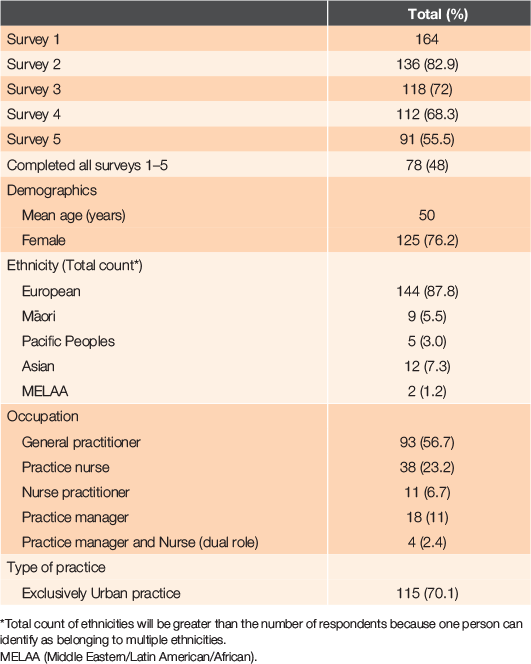
|
We defined five major themes relating to prescribing: changes to prescribing medicines; benefits of electronic prescriptions; technical challenges; clinical and medication supply challenges; and opportunities for the future. Excerpts from survey responses are identified by the discipline of the respondent.
Changes to prescribing medication
The lockdown period and rise in use of telehealth precipitated an immediate change to the way medicines were prescribed in primary care (Table 2). Most respondents reported that their practices moved promptly from issuing paper scripts to contactless (including electronic (e-)) prescribing.
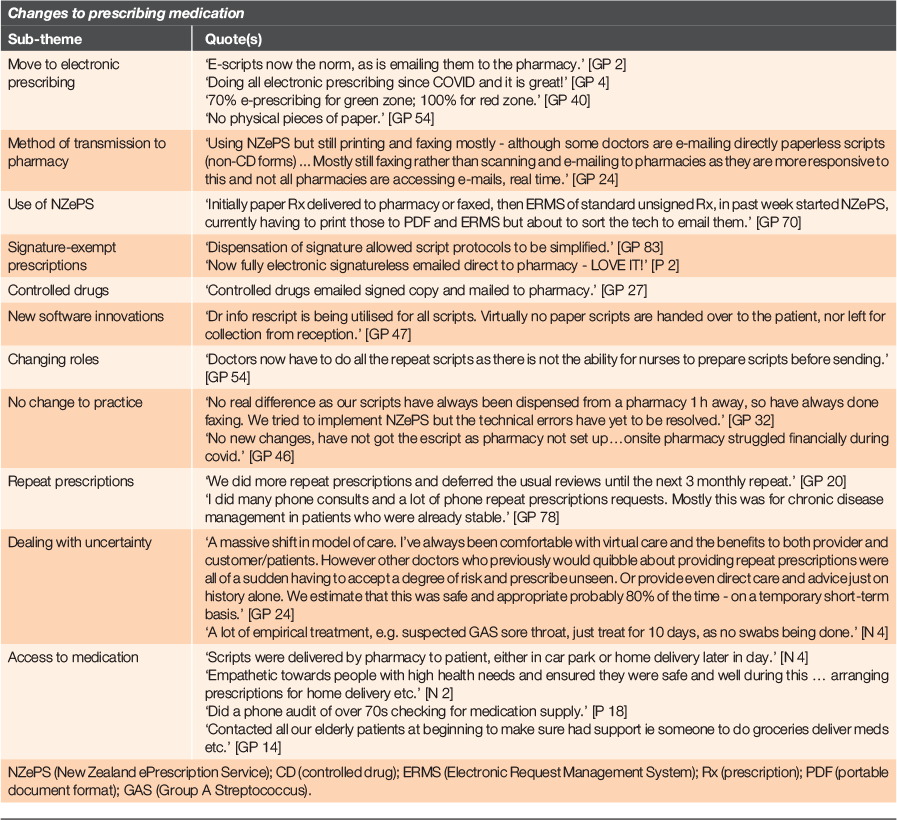
|
Survey respondents used a variety of methods to send prescriptions to pharmacies, with email and fax used most frequently. Some practices were already using the NZePS service, but the lockdown provided the impetus for others to enrol in the system. Respondents reported that the changes to prescribing rules meant that practices not using NZePS could also send most prescriptions electronically, direct to pharmacies. When prescriptions were generated electronically, practices still needed to notify the chosen pharmacy and in the case of NZePS, provide the pharmacy with a barcode. This prompted a small number of respondents’ practices to use new software enabling more seamless transmission from the practice management system (PMS) to the pharmacy, replacing the additional steps required to email or fax the prescription. Survey responses showed some regional differences: Canterbury respondents could use the local Electronic Referral Management Service (ERMS) to send prescriptions securely to the pharmacy, but for some, this was complicated.
Increased use of electronic prescribing changed work roles in practices. Whereas previously, nurses often generated repeat prescriptions, which were then signed by doctors, signatureless prescribing needs to be done by prescribers themselves. There was wide variability between practices. Although many mentioned making the types of changes described here, many others reported no change in the way prescriptions were generated.
Respondents also reported changes to usual protocols around prescribing without an in-person appointment. Practices tended to relax limits on the number of repeat prescriptions allowed without seeing a patient in-person, particularly if patients were considered stable. Respondents acknowledged that this shift to non-contact prescribing inevitably introduced more uncertainty.
There were many efforts described to ensure patients had access to medicines. Practices proactively contacted vulnerable patients to ensure they had adequate supplies of their medications. Home deliveries were arranged by practices and pharmacies to enable patients who were especially vulnerable to stay home.
Benefits of electronic prescriptions
Many respondents were enthusiastic about the changes, noting a wide range of benefits for both practices and patients (Table 3). To the broad question ‘what do you think has been successful so far?’ regarding changes in response to the COVID-19 pandemic, numerous respondents highlighted the switch to e-prescribing. E-prescribing was seen as an important tool in creating a safe environment to avoid spread of COVID-19, minimising handling, and reducing in-person contact.

|
There were also efficiencies, with time and cost saving for practice staff. The elimination of signatures was singled out by many respondents as a particular benefit. As highlighted in survey one, prescribers could work from home further reducing the interpersonal contact between practice staff during the lockdown. Another advantage of e-prescribing combined with telehealth, was that the many people who relocated for the lockdown period were able to have continuity of care regardless of where they were in New Zealand.
Many respondents reported their satisfaction that the pandemic had finally brought about changes that primary care had been requesting for a long time. They drew attention to the benefits of being forced into a bold change by circumstances.
Technical challenges with prescribing changes
Many respondents experienced frustrations and technical difficulties (Table 4). Some practices were already used to e-prescribing, but others were not and had the extra stress of having to learn quickly in a time of crisis. Some respondents reported difficulty in achieving reliable transmission of prescriptions to the chosen pharmacy and any issues required time-intensive follow up. Respondents noted that not all pharmacies could receive their e-prescriptions. These technical problems undermined confidence in the viability of using electronic transmission, with respondents reporting that they returned to older, more reliable methods in the meantime. Respondents also acknowledged that pharmacies were working under strain, with a huge increase in demand for prescriptions.
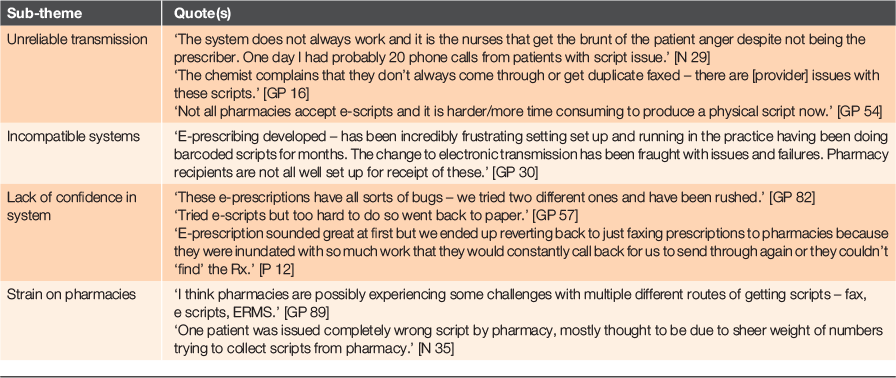
|
Administrative delays and resource constraints also limited the uptake of e-prescribing. One respondent noted that not only had they been ‘unable to set up electronic scripts due to hold up at PHO’, they had, in addition, been struggling with a ‘broken printer for six to eight weeks now’ [GP 41]. Others found e-prescribing difficult to integrate with their PMS and were ‘looking at whole new PMS… - an expensive and time intensive change required by the rapid changes in our work, and a whole new stress on the practice finances and morale’ [GP 7].
Clinical and medication supply challenges
There were also clinical concerns related to medicines management (Table 5). Prescribers worried about harm they might cause and whether they were practicing safely. There was a level of discomfort for some in the number of ‘repeat scripts being given out instead of patients being seen’ [GP 89].
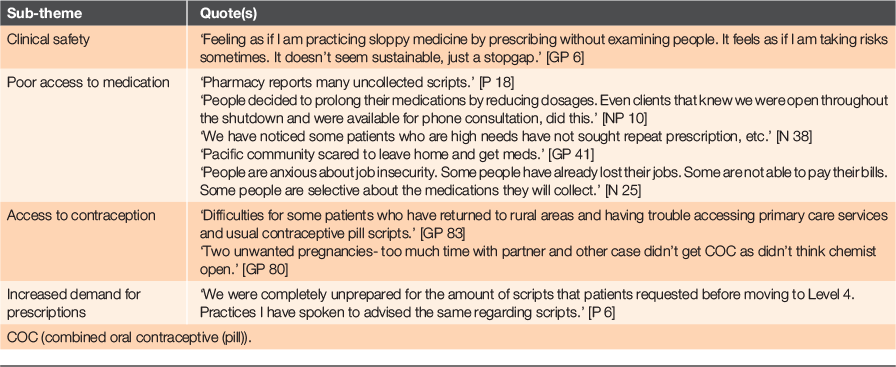
|
Respondents also became aware of patients making different decisions about when to take medicines. There were reports that some vulnerable individuals and communities were going without medicines or had cut back the amount they were taking because they were ‘… too scared to go out’ [P 7] to pick up the medicines from their pharmacy or due to financial pressures. Access to contraception was commonly affected.
The opposite reaction occurred among patients who feared they would not get the medicines they needed and attempted to stockpile. In some practices, there was ‘high demand’ [N 34] and ‘panic buying’ [GP 29] by patients who had heard media reports of supply shortages caused by the pandemic.
Opportunities for the future
E-prescribing was highlighted by numerous respondents as early as the first survey, as being one of the main successes of the primary care pandemic response. This was confirmed in the fifth and final survey where respondents were overwhelmingly positive and optimistic about the role of e-prescribing, with many suggesting that it should be embedded into future practice (Table 6). Others similarly expressed hopes of moving towards ‘e-prescribing to be fully integrated and used long term’ [GP 12], ‘scripts direct to pharmacies as routine’ [GP 81] and ‘here to stay’ [GP 61].
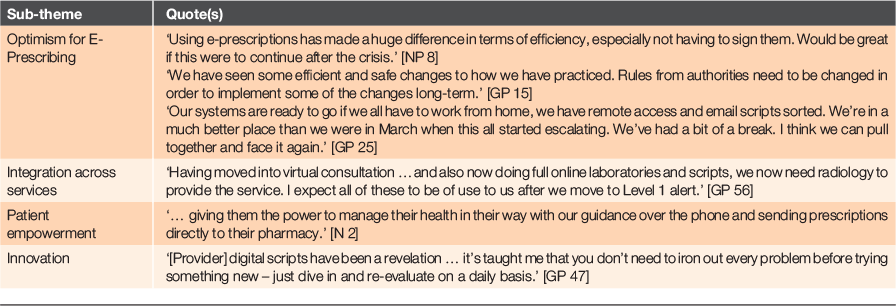
|
The enthusiasm for changed prescribing practices was across all respondents, indicating that even respondents who had negative experiences with e-prescribing during the lockdown recognised the limitations had been largely technical and would eventually be resolved when there were ‘easier ways to electronically send scripts’ [GP 74], when ‘e-prescriptions [were] working seamlessly’ [P 14], and when their practice had access to the required technology. As late as the final survey in August 2020, it was reported ‘we still have no access to video consultations and e-prescriptions as of yet so that is something that needs to change’ [GP 41].
Positively, respondents indicated that the COVID-19 experience with e-prescribing had resulted in ‘improved pharmacy relationships and co-planning’ [GP 80] and highlighted the valuable opportunities for greater integration across a range of other services.
The clinical concerns around e-prescribing did not appear to be a barrier for the future, as they were largely specific to the early part of the lockdown when consultations had nearly all been virtual. By the time of the final survey, practices had opened up to in-person appointments, easing apprehensions about being unable to examine patients adequately. The pressure to simply roll over repeats rather than see the patient had eased. Efficiencies of e-prescribing remained and allowed the ‘best of both worlds’, providing a paperless online process while retaining, in parallel, the option for generating a paper prescription for patients, if requested. These changes were viewed as being associated with a sense of empowerment for patients. Several respondents noted that benefits in innovation and new ways of working in primary care had emerged from being plunged into a crisis.
Discussion
We have described the changes and challenges of prescribing medication during the early days of the COVID-19 pandemic in New Zealand. The results demonstrate the agility of general practice in rapidly adapting to change and, as perceived by our study participants, community pharmacies equally rose to the challenge.
Many respondents moved swiftly towards e-prescribing as an adjunct to telehealth and this is reflected in Ministry of Health data showing the rapid uptake of general practices activating NZePS in early 2020.6 The move to e-prescribing was framed by most of our respondents as a success and a long-awaited change; the greatest challenges appeared to be technical, and respondents were optimistic about their resolution. Some prescribers made additional software changes to make the process more seamless, a finding previously noted in the local literature.12
Technology issues, including a lack of funding for information technology (IT) applications and perceptions that vendors were not delivering acceptable products, have been identified as primary barriers to e-health in previous international research.13 In this study, respondents shared concerns about technology issues undermining benefits and sometimes resulting in e-prescribing being abandoned. Prescribers and pharmacists sometimes had incompatible systems resulting in unreliable and work-intensive transmission of prescriptions. The challenges of setting up interoperable health IT systems have been described elsewhere.14 Additionally, pharmacists still require a paper copy of NZePS prescriptions to scan the barcode (to access the prescription) and are required to retain a paper copy. So, although prescribers saved time by not printing prescriptions, this task fell to dispensers. There is still regional variation in the use of NZePS,6 warranting further investigation into prescriber and dispenser experiences of the system. To maximise benefits, NZePS must be a fully integrated e-prescribing system and funded appropriately.
Respondents expressed concerns about high-needs groups (including Māori, Pacific peoples, elderly and people living rurally) not accessing medicines as they usually would. These people may be most at risk of poor health outcomes and if barriers are not addressed, inequities may be exacerbated. A study of community pharmacists during COVID-19 in the Netherlands echoes the concern that vulnerable populations may be more adversely affected by logistical changes to prescribing and dispensing.15 They concluded that decreased opportunity for medication education and counselling by pharmacists during COVID-19 may adversely affect vulnerable groups who were already at increased risk of drug-related problems.15 Some practices in our sample took steps to ensure medication supply to high-needs patient groups by contacting patients proactively and linking them with local home delivery services often run by pharmacy teams, and in some areas, local community groups also provided support.16 There appears to be inconsistent provision of home delivery of medicines across New Zealand. In Australia, the Home Medicine Service was formed in response to the pandemic to support pharmacies to provide medication home delivery, and it may be that New Zealand could adopt a similar system.17
A strength of this study is its reporting from a large, diverse group of primary care team members from throughout New Zealand. These respondents were followed as the pandemic progressed, enabling us to observe changes over time. The pandemic is viewed by many as a catalyst for the shift to electronic provision of health care,18 and this study documents the primary care prescriber experience at this important transition point.
The primary limitation in this study is that we did not include pharmacy teams. The viewpoint of dispensers would provide important context for our findings and this is an opportunity for future research. Our data collection was largely from free-text comments providing qualitative results; however, it would be useful for future research to gather quantitative data to examine effects of changes to prescribing medications during the COVID-19 pandemic.
Prescribing medication in New Zealand general practice has undergone considerable change, moving swiftly towards e-prescribing. There is a clear mandate to continue with the acceleration of available and developing technology, which is consistent and interoperable between prescribers and dispensers. We highlight the importance of planning, policy and actions focused on maintaining access to medicines through large-scale disruptive events, particularly for vulnerable populations. Our sample is hopeful that at a governance level, regulatory changes facilitating remote prescribing will be made permanent. With these changes, we are optimistic that e-prescribing is a safe, efficient tool for future primary care and that patients can safely continue to access their medications through any future disruption occurring during the COVID-19 pandemic.
Competing interests
The authors declare no competing interests.
Funding
This research was internally funded and did not receive any specific funding.
Data Availability Statement
The data that support this study cannot be publicly shared due to ethical or privacy reasons and may be shared upon reasonable request to the corresponding author, if appropriate.
Acknowledgements
We thank the Department of General Practice, University of Otago, Christchurch, for sponsoring this research, and Pegasus Health (Charitable) Ltd for providing statistical and quantitative analysis and providing consultation with the Director of Hauora Māori and Equity, Irihāpeti Mahuika. We also thank Community Pharmacists, Lisa Wallace and Deb Hart, for their advice on the experience of pharmacists. Lastly, we thank the large number of primary health-care professionals who gave their time and insights by participating in this study during such a busy time in their working and personal lives.
References
[1] Royal New Zealand College of General Practitioners. GPs open for business – but changing the way they see patients [press release]. 2020. [cited 2021 February 10]. Available from: https://www.rnzcgp.org.nz/RNZCGP/News/College_news/2020/GPs-open-for-business.aspx[2] New Zealand Government. Unite against COVID-19: History of the COVID-19 Alert System. 2021. [cited 2021 February 23]. Available from: https://covid19.govt.nz/alert-levels-and-updates/history-of-the-covid-19-alert-system/
[3] Ministry of Health (NZ). New rules for electronic prescriptions to support virtual care in the community. 2020. [cited 2021 February 23]. Available from: https://www.health.govt.nz/system/files/documents/pages/covid-19-new_rules_for_electronic_prescriptions-3apr20.pdf
[4] Pharmaceutical Management Agency (NZ). COVID-19: Dispensing frequency. 2020. [cited 2021 January 8]. Available from: https://pharmac.govt.nz/news-and-resources/covid19/dispensing-frequency/.
[5] Pharmaceutical Management Agency (NZ). COVID-19: Medicines with amended access criteria. 2020. [cited 2021 January 8]. Available from: https://pharmac.govt.nz/news-and-resources/covid19/covid-19-information-for-prescribers/covid-19-medicines-with-amended-access-criteria/.
[6] Ministry of Health (NZ). New Zealand ePrescription Service. 2020. [cited 2021 January 18]. Available from: https://www.health.govt.nz/our-work/digital-health/other-digital-health-initiatives/emedicines/new-zealand-eprescription-service.
[7] Canterbury Primary Response Group. COVID-19 Updates & Resources: Director-General Waiver under Regulation 43 Medicines Regulations 1984. 2020. [cited 2021 February 10]. Available from: https://www.primaryhealthresponse.org.nz/previous_event/director-general-waiver-under-regulation-43-medicines-regulations-1984-27-march-2020/
[8] Atmore C, Stokes T. Turning on a dime: pre- and post-COVID-19 consultation patterns in an urban general practice. N Z Med J. 2020; 133 65–75.
| 33032304PubMed |
[9] Imlach F, McKinlay E, Middleton L, et al. Telehealth consultations in general practice during a pandemic lockdown: survey and interviews on patient experiences and preferences. BMC Fam Pract. 2020; 21 269
| Telehealth consultations in general practice during a pandemic lockdown: survey and interviews on patient experiences and preferences.Crossref | GoogleScholarGoogle Scholar | 33308161PubMed |
[10] Wilson G, Currie O, Bidwell S, et al. Empty waiting rooms: The New Zealand General Practice experience with telehealth during the COVID-19 pandemic. N Z Med J. 2021; 134 89–101.
| 34239148PubMed |
[11] Kolb SM. Grounded theory and the constant comparative method: valid research strategies for educators. J Emerg Trends Educ Res Policy Stud. 2012; 3 83–6.
[12] Lillis S, Lack L. Repeat prescribing policy in New Zealand general practice: making it better. J Prim Health Care. 2020; 12 373
| 33349326PubMed |
[13] Anderson JG. Social, ethical and legal barriers to e-health. Int J Med Inform. 2007; 76 480–3.
| 17064955PubMed |
[14] McKenna R. Using information and communications technology to enable the exchange of information between New Zealand clinicians and health providers. N Z Med J. 2010; 123 92–104.
| 20581917PubMed |
[15] Koster ES, Philbert D, Bouvy ML. Impact of the COVID-19 epidemic on the provision of pharmaceutical care in community pharmacies. Res Social Adm Pharm. 2021; 17 2002–4.
| Impact of the COVID-19 epidemic on the provision of pharmaceutical care in community pharmacies.Crossref | GoogleScholarGoogle Scholar | 33317768PubMed |
[16] Canterbury Primary Response Group. CPRG Update for Community Pharmacy – 2 April 2020 [Internet]; 2020. [cited 2021 January 18]. Available from: https://www.primaryhealthresponse.org.nz/wp-content/uploads/2020/05/CPRG-COVID-19-Pharmacy-Update-2-April-2020_FINAL.pdf.
[17] Bell JS, Reynolds L, Freeman C, Jackson JK. Strategies to promote access to medications during the COVID-19 pandemic. Aust J Gen Pract. 2020; 49 530–2.
| Strategies to promote access to medications during the COVID-19 pandemic.Crossref | GoogleScholarGoogle Scholar | 32738870PubMed |
[18] Baird B, Maguire D. Understanding factors that enabled digital service change in general practice during the Covid-19 pandemic. London: The King’s Fund; 2021 [cited 2021 February 16]. Available from: https://www.kingsfund.org.uk/publications/digital-service-change-general-practice-during-covid-19.


